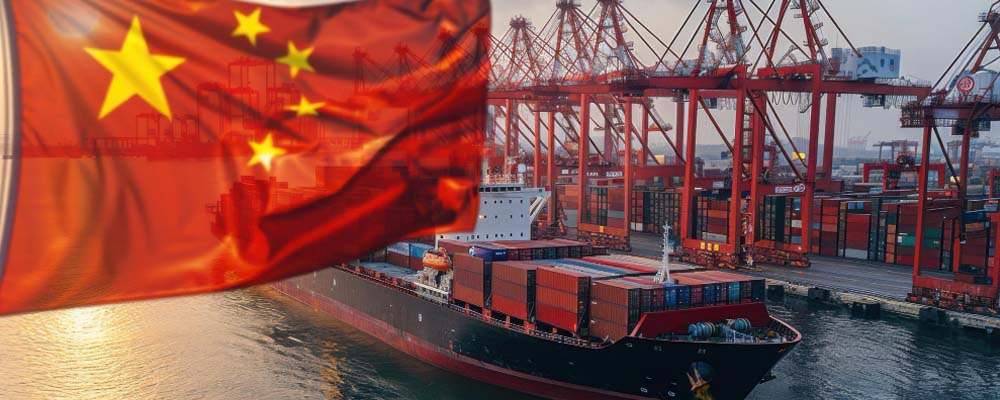
China’s position as a global trade giant is indisputable. Understanding its key exports and imports is crucial for businesses in the logistics and freight forwarding industry. This blog post dives deep into the intricacies of China’s main exports and imports, providing essential insights for freight forwarding companies, logistics providers, importers, exporters, customs brokers, and more.
China’s Main Exports
China has established itself as the world’s largest exporter, with a diverse array of products reaching every corner of the globe. But what exactly does China export the most?
Electronics and Machinery
Electronics and machinery dominate China’s export landscape. Items such as smartphones, computers, and integrated circuits lead the charge, driven by high global demand. Companies like Huawei, Xiaomi, and Lenovo have become household names worldwide, contributing significantly to this sector.
The machinery segment includes industrial machines, engines, and power-generating equipment. This extensive range of products is essential for various industries, from manufacturing to energy.
Textiles and Apparel
China’s textile and apparel industry is another significant contributor to its export economy. The country is known for producing both high-quality and affordable clothing and fabrics. Brands like Shein have skyrocketed in popularity, thanks to China’s efficient production capabilities.
The global fashion industry’s reliance on Chinese textiles is immense, impacting everything from fast fashion to high-end designer labels. This sector’s strength lies in its vast manufacturing infrastructure and innovative production techniques.
Consumer Goods
Consumer goods, including toys, furniture, and household items, are also major exports. Companies like Haier (appliances) and DJI (drones) exemplify China’s prowess in creating innovative products that cater to global consumers.
Chinese toys, in particular, hold a substantial market share, with brands like Lego leveraging Chinese manufacturing capabilities to meet demand. This segment’s growth is fueled by competitive pricing and continuous innovation.
 The Global Demand for Chinese Products
The Global Demand for Chinese Products
The world’s appetite for Chinese products shows no signs of waning. Several factors contribute to this sustained demand.
Competitive Pricing
China’s ability to produce goods at lower costs without compromising quality has made it an attractive source for global buyers. Economies of scale and efficient production processes enable Chinese manufacturers to offer competitive prices.
Technological Advancements
China has heavily invested in technology and innovation, making it a leader in various sectors. From 5G technology to AI and robotics, Chinese companies are at the forefront, driving global demand.
Diverse Product Range
The variety of products available from China is unmatched. Whether it’s high-tech electronics, everyday consumer goods, or specialized industrial equipment, China offers a comprehensive range that meets diverse market needs.
Strategic Trade Relationships
China has cultivated strong trade relationships with numerous countries. Partnerships through initiatives like the Belt and Road Initiative have opened new markets and strengthened existing ties.
China’s Main Imports
While China is a major exporter, it also imports a substantial amount of goods to support its massive economy. These imports are vital for sustaining its industrial and consumer markets.
Crude Oil and Natural Gas
Energy sources like crude oil and natural gas top China’s import list. With its rapidly growing economy and increasing energy needs, China imports vast quantities from countries like Saudi Arabia and Russia.
These imports are crucial for powering industries and supporting urban development. China’s energy import strategy also focuses on diversifying sources to ensure stable supply chains.
Integrated Circuits
Integrated circuits are essential for China’s burgeoning electronics industry. Despite being a leading electronics exporter, China relies on imports for high-quality semiconductors from countries like Taiwan and South Korea.
The demand for integrated circuits is driven by the need for advanced technology in consumer electronics, automotive, and industrial applications.
Soybeans and Agricultural Products
China imports significant quantities of soybeans and other agricultural products, primarily from the United States and Brazil. These imports are vital for the country’s food security and livestock feed industry.
The agricultural import sector also includes grains, meat, and dairy products, reflecting China’s efforts to meet its population’s dietary needs.
 The Impact of Imports on the Chinese Economy
The Impact of Imports on the Chinese Economy
Imports play a critical role in China’s economic landscape, influencing various aspects of its development and growth.
Supporting Industrial Growth
Imported raw materials and components are essential for China’s manufacturing and industrial sectors. They enable the production of finished goods that are exported worldwide, contributing to economic growth.
Enhancing Technological Capabilities
By importing advanced technology and machinery, China enhances its own production capabilities. This transfer of technology facilitates innovation and boosts competitiveness.
Addressing Domestic Demand
Imports help meet the domestic demand for products that are either unavailable or insufficiently produced locally. This includes luxury goods, specialty foods, and high-end technology.
The Role of Customs Brokers and Freight Forwarders
Navigating the complex world of international trade requires expertise, and that’s where customs brokers and freight forwarders come in.
Ensuring Compliance
Customs brokers ensure that all imports and exports comply with the relevant regulations. They handle documentation, tariffs, and taxes, ensuring that goods move smoothly across borders.
Efficient Logistics Management
Freight forwarders orchestrate the logistics of transporting goods from one country to another. They manage shipping routes, warehousing, and transportation modes, optimizing the supply chain for cost and efficiency.
Risk Management
Both customs brokers and freight forwarders play a crucial role in managing risks associated with international trade. They offer solutions for insurance, loss prevention, and mitigation strategies to safeguard shipments.
 Conclusion
Conclusion
Understanding China’s main exports and imports is essential for stakeholders in the freight forwarding and logistics industries. The country’s diverse export portfolio, coupled with its strategic import practices, underscores its role as a global trade powerhouse.
For freight forwarders, importers, exporters, and logistics providers, staying informed about these trends can unlock new opportunities and enhance operational efficiency. Whether it’s leveraging China’s competitive pricing or navigating the complexities of customs regulations, knowledge is the key to success.
Take the next step in optimizing your logistics strategy by staying updated on the latest trade insights and partnering with experts who can guide you through the intricacies of the global market.




 The Global Demand for Chinese Products
The Global Demand for Chinese Products The Impact of Imports on the Chinese Economy
The Impact of Imports on the Chinese Economy Conclusion
Conclusion



